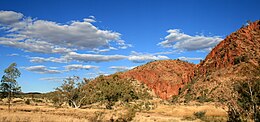This article should specify the language of its non-English content, using {{lang}}, {{transliteration}} for transliterated languages, and {{IPA}} for phonetic transcriptions, with an appropriate ISO 639 code. Wikipedia's multilingual support templates may also be used. (December 2022) |
| Mudbura | |
|---|---|
| Native to | Northern Territory, Australia |
| Region | Victoria River to Barkly Tablelands |
| Ethnicity | Mudbura, Kwarandji |
Native speakers | 92 (2016 census)[1] |
Pama–Nyungan
| |
| Mudbura Sign Language | |
| Language codes | |
| ISO 639-3 | dmw |
| Glottolog | mudb1240 |
| AIATSIS[1] | C25 |
| ELP | Mudburra |
Mudburra, also spelt Mudbura, Mudbarra and other variants, and also known as Pinkangama, is an Aboriginal language of Australia.
McConvell suspects Karrangpurru was a dialect of Mudburra because people said it was similar. However, it is undocumented and thus formally unclassifiable.[1]
The language Mudburra is native to the western area of Barkly Region, southern area of Sturt Plateau and eastern area of Victoria River District, in Northern Territory Australia.[2] Furthermore, the areas in which the Mudbura people live are Yingawunarri (Top Springs), Marlinja (Newcastle Waters Station), Kulumindini (Elliott) and Stuart Highway.[2]
Information from the 2016 Australian census documented that there were 96 people speaking the Mudburra language, while other reports state that fewer than 10 people speak it fluently. It was also reported that children do not learn the traditional form of the language any more.[2]

- ^ a b c C25 Mudbura at the Australian Indigenous Languages Database, Australian Institute of Aboriginal and Torres Strait Islander Studies
- ^ a b c Meakins, Felicity (2021). Mudburra to English Dictionary. Chicago: Aboriginal Studies Press. ISBN 978-1-925302-59-2. OCLC 1255228353.